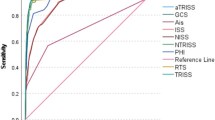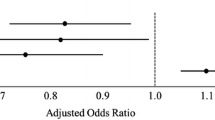Abstract
Purpose
The aim of this study was to examine prognostic factors in polytraumatic patients with liver injury and to develop a scoring system for traumatic liver injury (SSTLI) to predict mortality.
Methods
The medical records of 175 patients treated for traumatic liver injury from July 2009 to April 2013 were reviewed. The primary outcome variable was hospital mortality. All risk factors were analyzed by multivariate logistic regression analysis. The SSTLI was created based on the predictive power of each factor.
Results
Age, injury severity score (ISS), trauma and injury severity score, the shock index, and the volume of packed red blood cells transfused were strong predictors of mortality. We hypothesized that the SSTLI would use five clinical measures (total bilirubin, prothrombin time, serum creatinine, age, and ISS). Each measure was scored 0–1 (age and ISS) or 0–3 (total bilirubin, prothrombin time, and creatinine), with 3 indicating the most severe derangement. The receiver-operating characteristic curve of the SSTLI was significant at post-traumatic days 0, 1, 3, and 5 [area under the curve (AUC), 0.830; AUC, 0.912; AUC, 0.941; and AUC, 0.930, respectively]. A value of 5 points was the threshold for reliability dividing low-risk (<5) from high-risk (≥5) patients.
Conclusions
The SSTLI may be available to predict mortality in polytraumatic patients with liver injury, although external validation is needed before widespread implementation.






Similar content being viewed by others
References
Badger SA, Barclay R, Campbell P, Mole DJ, Diamond T. Management of liver trauma. World J Surg. 2009;33(12):2522–37. doi:10.1007/s00268-009-0215-z.
Ozogul B, Kisaoglu A, Aydinli B, Ozturk G, Bayramoglu A, Saritemur M, et al. Non-operative management (NOM) of blunt hepatic trauma: 80 cases. Ulusal travma ve acil cerrahi dergisi =Turkish J Trauma Emerg Surg : TJTES. 2014;20(2):97–100. doi:10.5505/tjtes.2014.20737.
Pachter HL, Hofstetter SR. The current status of nonoperative management of adult blunt hepatic injuries. Am J Surg. 1995;169(4):442–54.
Feliciano DV, Rozycki GS. Hepatic trauma. Scand J Surg. 2002;91(1):72–9.
Stassen NA, Bhullar I, Cheng JD, Crandall M, Friese R, Guillamondegui O, et al. Nonoperative management of blunt hepatic injury: an eastern association for the surgery of trauma practice management guideline. J Trauma Acute Care Surg. 2012;73(5 Suppl 4):S288–93. doi:10.1097/TA.0b013e318270160d.
Parks RW, Chrysos E, Diamond T. Management of liver trauma. Br J Surg. 1999;86(9):1121–35. doi:10.1046/j.1365-2168.1999.01210.x.
Gourgiotis S, Vougas V, Germanos S, Dimopoulos N, Bolanis I, Drakopoulos S, et al. Operative and nonoperative management of blunt hepatic trauma in adults: a single-center report. J Hepato-Biliary-Pancreat Surg. 2007;14(4):387–91. doi:10.1007/s00534-006-1177-2.
Kozar RA, McNutt MK. Management of adult blunt hepatic trauma. Curr Opin Crit Care. 2010;16(6):596–601. doi:10.1097/MCC.0b013e32833f5cd5.
Knaus WA, Draper EA, Wagner DP, Zimmerman JE. Apache II: a severity of disease classification system. Crit Care Med. 1985;13(10):818–29.
Baker SP, O’Neill B, Haddon W Jr, Long WB. The injury severity score: a method for describing patients with multiple injuries and evaluating emergency care. J Trauma. 1974;14(3):187–96.
Champion HR, Sacco WJ, Copes WS, Gann DS, Gennarelli TA, Flanagan ME. A revision of the trauma score. J Trauma. 1989;29(5):623–9.
Kimura A, Chadbunchachai W, Nakahara S. Modification of the trauma and injury severity score (TRISS) method provides better survival prediction in Asian blunt trauma victims. World J Surg. 2012;36(4):813–8. doi:10.1007/s00268-012-1498-z.
Boyd CR, Tolson MA, Copes WS. Evaluating trauma care: the TRISS method. Trauma score and the injury severity score. J Trauma. 1987;27(4):370–8.
Champion HR, Sacco WJ, Copes WS. Injury severity scoring again. J trauma. 1995;38(1):94–5.
Zeger SL, Liang KY, Albert PS. Models for longitudinal data: a generalized estimating equation approach. Biometrics. 1988;44(4):1049–60.
Moore EE, Cogbill TH, Jurkovich GJ, Shackford SR, Malangoni MA, Champion HR. Organ injury scaling: spleen and liver (1994 revision). J Trauma. 1995;38(3):323–4.
Osler T, Rutledge R, Deis J, Bedrick E. ICISS: an international classification of disease-9 based injury severity score. J Trauma. 1996;41(3):380–6; discussion 6-8.
West TA, Rivara FP, Cummings P, Jurkovich GJ, Maier RV. Harborview assessment for risk of mortality: an improved measure of injury severity on the basis of ICD-9-CM. J Trauma. 2000;49(3):530–40; discussion 40–1.
Talving P, Lustenberger T, Okoye OT, Lam L, Smith JA, Inaba K, et al. The impact of liver cirrhosis on outcomes in trauma patients: a prospective study. J Trauma Acute Care Surg. 2013;75(4):699–703. doi:10.1097/TA.0b013e31829a2c19.
Corneille MG, Nicholson S, Richa J, Son C, Michalek J, Wolf SE, et al. Liver dysfunction by model for end-stage liver disease score improves mortality prediction in injured patients with cirrhosis. J Trauma. 2011;71(1):6–11. doi:10.1097/TA.0b013e31822311c5.
Seamon MJ, Franco MJ, Stawicki SP, Smith BP, Kulp H, Goldberg AJ, et al. Do chronic liver disease scoring systems predict outcomes in trauma patients with liver disease? a comparison of MELD and CTP. J Trauma. 2010;69(3):568–73. doi:10.1097/TA.0b013e3181ec0867.
Pachter HL, Feliciano DV. Complex hepatic injuries. Surg Clinics N. Am. 1996;76(4):763–82.
Di Saverio S, Catena F, Filicori F, Ansaloni L, Coccolini F, Keutgen XM, et al. Predictive factors of morbidity and mortality in grade IV and V liver trauma undergoing perihepatic packing: single institution 14 years experience at European trauma centre. Injury. 2012;43(9):1347–54. doi:10.1016/j.injury.2012.01.003.
Chen RJ, Fang JF, Lin BC, Hsu YP, Kao JL, Chen MF. Factors determining operative mortality of grade V blunt hepatic trauma. J Trauma. 2000;49(5):886–91.
Tran DD, Cuesta MA, van Leeuwen PA, Nauta JJ, Wesdorp RI. Risk factors for multiple organ system failure and death in critically injured patients. Surgery. 1993;114(1):21–30.
Moseley RH. Sepsis and cholestasis. Clin Liver Dis. 2004;8(1):83–94. doi:10.1016/S1089-3261(03)00134-X.
Plessier A, Denninger MH, Consigny Y, Pessione F, Francoz C, Durand F, et al. Coagulation disorders in patients with cirrhosis and severe sepsis. Liver Int : Off J Int Assoc Study Liver. 2003;23(6):440–8.
Ferreira AM, Sakr Y. Organ dysfunction: general approach, epidemiology, and organ failure scores. Semin Respir Crit Care Med. 2011;32(5):543–51. doi:10.1055/s-0031-1287862.
Child CG. The liver and portal hypertension. Major problems in clinical surgery. vol. 1. Philadelphia: Saunders; 1964.
Acknowledgments
This study was supported by a clinical research grant from Pusan National University Hospital 2013.
Conflict of interest
No potential conflict of interest relevant to this article is reported. Ho Hyun Kim, Jae Hun Kim, Chan-Yong Park, and Hyun Min Cho declare that they have no conflict of interest.
Ethical standard
This project received research approval from the Research Ethics Board of the local university and was therefore performed in accordance with the ethical standards set forth in the 1964 Declaration of Helsinki and its later amendments.
Author information
Authors and Affiliations
Corresponding author
Rights and permissions
About this article
Cite this article
Kim, H.H., Kim, J.H., Park, CY. et al. Scoring system for traumatic liver injury (SSTLI) in polytraumatic patients: a predictor of mortality. Eur J Trauma Emerg Surg 41, 375–385 (2015). https://doi.org/10.1007/s00068-014-0454-z
Received:
Accepted:
Published:
Issue Date:
DOI: https://doi.org/10.1007/s00068-014-0454-z




